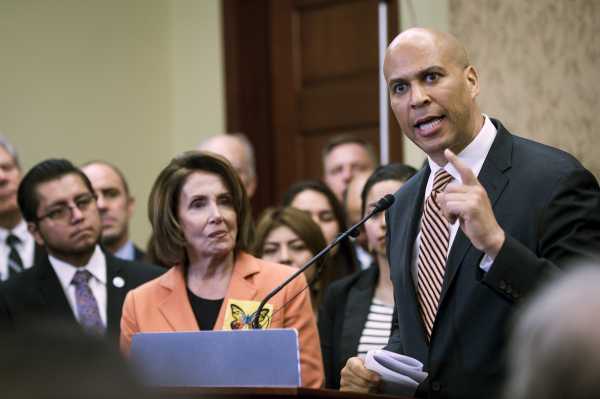
Sen. Cory Booker (D-NJ) has a big idea: give 15 local areas federal money so they can guarantee all their residents a job.
The Federal Jobs Guarantee Development Act, announced by Booker on Friday, would establish a three-year pilot program in which the Department of Labor would select up to 15 local areas (defined in the bill as any political subdivision of a state, like a city or a county, or a group of cities and counties) and offer that area funding so that every adult living there is guaranteed a job paying at least $15 an hour (or the prevailing wage for the job in question, whichever’s higher) and offering paid family/sick leave and health benefits.
The idea of a government job guarantee ensuring all adults who want employment get it has a long history in American politics, but it has gained popularity as the Democratic Party has sought to embrace bigger and more ambitious economic policies in the wake of the 2016 election.
Booker’s plan is essentially a pilot version of a proposal from Duke’s Mark Paul and William Darity, Jr. and the New School’s Darrick Hamilton, economists who have, together and individually, advocated a job guarantee for years, well before the current surge in enthusiasm. Most recently, Paul, Darity, and Hamilton wrote up their proposal for the Center on Budget and Policy Priorities, a highly influential left-of-center think tank, in a clear sign the idea was gaining traction. Booker’s bill is an even bigger step forward.
“The federal jobs guarantee is an idea that demands to be taken seriously,” Booker said in a statement. “Creating an employment guarantee would give all Americans a shot at a day’s work and, by introducing competition into the labor market, raise wages and improve benefits for all workers.”
The policy case for a job guarantee
The idea of a job guarantee serves both a policy and a political purpose.
On the policy side, a job guarantee would, in theory, effectively end recessions in America. Right now, the US government’s strategy when the economy stops growing is to use a combination of monetary stimulus (in which the Federal Reserve cuts interest rates or buys up billions of dollars of long-term bonds) and fiscal stimulus (as in the 2009 stimulus package, which blended a boost in spending with temporary tax cuts).
For a variety of political and institutional factors, the Fed and Congress weren’t able to do enough in 2008 to 2010 to prevent unemployment from breaking 10 percent, and they certainly weren’t able to effect a full recovery within a couple years. Returning to normal unemployment rates took nearly a decade, resulting in years of human misery and lost wage gains that a healthier and faster recovery could’ve delivered.
Job guarantee advocates argue that their plan effectively creates a permanent form of fiscal stimulus that politicians wouldn’t need to scramble to pass whenever disaster hits. Instead, if the economy took a turn for the worse and companies started shedding jobs, the government would automatically soak up anyone who’s laid off and give them work. That, in turn, would put more money in consumers’ pockets, boosting demand and improving business’ prospects. Before you know it, the economy’s back to normal.
Advocates argue the policy could prove beneficial during economic booms as well. The fruits of economic recoveries and booms aren’t evenly shared, demographically. As of March 2018, 60.7 percent of white people in America were employed, but only 58.4 percent of black people were.
Once black men’s disproportionate representation in prisons and jails is accounted for, the gap grows still larger. In 2016, the most recent year for which we have data, a mere 27.7 percent of people with disabilities age 16 to 64 were employed, compared to 72.8 percent of nondisabled people.
Nor do booms affect all geographic areas equally. There are still 337 counties or county-equivalents with a combined labor force of over 6.7 million people that have unemployment rates of 7 percent or higher as of February 2018. Seventy-eight counties, like Yuma, Arizona, still have unemployment rates in excess of 10 percent.
A job guarantee would, in principle, lessen those inequalities. People in struggling regions would be guaranteed work without having to move. Black Americans and disabled Americans wouldn’t be expected to wait until employers have run out of white and nondisabled people to hire until they get their chance.
Finally, advocates argue that the policy would lead to an increase in wages for everyone. That’s a big benefit at a time when unemployment is low but wage growth is still sluggish.
Think of it this way: Walmart pays its employees a minimum of $10 per hour; part-time employees aren’t guaranteed benefits like health insurance or a 401(k) match.
If you’re a part-time employee at Walmart, and all of a sudden you can get $15 an hour, work full time, and earn full benefits by working for the federal government — wouldn’t you? And, knowing that, wouldn’t Walmart try to increase wages to keep you?
Advocates say Walmart would. And they have some empirical evidence on their side from India, where a type of job guarantee known as the National Rural Employment Guarantee Scheme functions largely as an insurance system, offering a source of income for rural farmers during the dry season.
A group of economists — UC San Diego’s Karthik Muralidharan and Paul Niehaus and the University of Virginia’s Sandip Sukhtankar — found that the job guarantee, they estimate, increased earnings for low-income households by 13.3 percent. Ninety percent of that increase is due to higher wages and increased work in the private sector, not the job guarantee program itself.
Just as job guarantee advocates would predict, the program bid up wages everywhere. Perhaps the most surprising result was that the program not only increased wages, but increased employment in the private sector.
The political case for a job guarantee — and the challenges it faces
The fact that Cory Booker, a rising star in the Democratic Party and a likely 2020 contender who faces considerable skepticism from the left due to his stances on education and Wall Street, has endorsed experimenting with a job guarantee is a clear indication that some in the party think it could be a political winner as well as a policy advance.
In the wake of the 2016 election, liberal commentators have latched onto the job guarantee as a way to forge a cross-racial working-class coalition. They need a plan that appeals to both to the white Wisconsin and Michigan voters who switched from Obama to Trump and to black and Latino workers left behind by deindustrialization. The ideal plan would both improve conditions for lower-income Americans while supporting Americans’ strong intuition that people should work to earn their crust.
“A federal job guarantee is both universal—it benefits all Americans—and specifically ameliorative to entrenched racial inequality,” Slate’s Jamelle Bouie noted.
“The job guarantee asserts that, if individuals bear a moral duty to work, then society and employers bear a reciprocal moral duty to provide good, dignified work for all,” Jeff Spross added in the influential center-left journal Democracy.
“If Democrats want to win elections, they should imbue Trump’s empty rhetoric with a real promise: a good job for every American who wants one,” wrote Bryce Covert in the New Republic. “It’s time to make a federal jobs guarantee the central tenet of the party’s platform.”
As with any sufficiently big idea, however, a job guarantee comes with risks. It would be expensive, for one thing. Paul, Darity, and Hamilton’s plan, as outlined for the CBPP, would cost $543 billion per year, they estimate. For context, that rivals the size of Medicare, which will cost $707 billion this year, and the size of the defense budget, which totals $622 billion. The Center for American Progress has proposed a more modest $158 billion per year government jobs plan, but it wouldn’t actually guarantee a job to all who sought one, as Paul, Darity, and Hamilton have proposed. Booker’s bill doesn’t have an estimated cost yet.
Second, it’s not clear what exactly participants in a job guarantee scheme would do. Most proposals are somewhat vague on this point, mentioning everything from child care to infrastructure. The Booker bill leaves most of this up to localities to figure out. Cities, counties, and other areas would get a chance to apply for the program, and the Department of Labor would be required to pick a mix of urban and rural areas to try the idea out in. Once the program was up and running, the vast majority of jobs offered would be in the public sector, and participants who need more skills development would be offered up to eight weeks of training.
Positions meeting “a list of national job priorities … that shall include child care, care for seniors and individuals with disabilities, [and] infrastructure activities” would be encouraged, and private sector employers would benefit from the Work Opportunity Tax Credit, a benefit which currently gives employers a few thousand dollars toward wages when they hire veterans, welfare or food stamp recipients, ex-felons, and other people with barriers to employment. But beyond that, the bill doesn’t give many specifics.
A job guarantee would ideally provide for jobs that are nice to have but could be nixed when the economy improves and the program shrinks in size. Those are pretty hard to identify. If a job guarantee were enacted in a recession, and many of the enrollees became child care providers, what happens when the economy improves and workers find jobs in the private sector? It wouldn’t be tenable to eliminate a universal child care program because the economy improved. Nor, if the program employed bus drivers, would it make much sense to cut bus routes.
The Booker bill requires that the program be subject to an ongoing rigorous evaluation, which would help determine how well-equipped local governments are to make those kinds of distinctions. That would be a welcome addition to the research literature, as there’s some past evidence suggesting programs like this struggle to succeed. Berkeley economist David Card recently conducted a meta-analysis of more than 200 evaluations of programs meant to boost labor markets, along with fellow economists Jochen Kluve and Andrea Weber. While they found a variety of impacts of different programs, one constant was that public employment programs that simply hired people directly performed worst.
“Public sector employment subsidies tend to have negligible or even negative impacts at all horizons,” the study concludes. “This pattern suggests that private employers place little value on the experiences gained in a public sector program.” One reason, they suggested, was that the programs did nothing to help build skills that would make participants more employable.
A job guarantee, though, would be on an entirely different scale, and the Booker bill would enable an evaluation that could determine if its effects are more like the successful Indian program or the failed efforts that Card, Kluve, and Weber studied.
With Donald Trump in the White House and Republicans in charge of both houses of Congress, it’s doubtful Booker’s bill will become law anytime soon. But that’s not really the point. Until his proposal, the closest thing there was to a job guarantee bill in Congress was Rep. John Conyers’s (D-MI) Humphrey-Hawkins 21st Century Full Employment and Training Act, named after a largely failed 1970s bill pushed by civil rights activists and unions to enact a job guarantee. But the bill fell short of establishing a formal guarantee, and Conyers has since resigned from Congress in a sexual harassment scandal.
Booker has put the idea back on the Democratic agenda, and in a form that could be readily passed at relatively minimal cost (given the pilot program nature) when Democrats are next in power. That’s an important step, and one that significantly improves the odds that the idea will be part of the next Democratic president’s to-do list.
Sourse: vox.com






